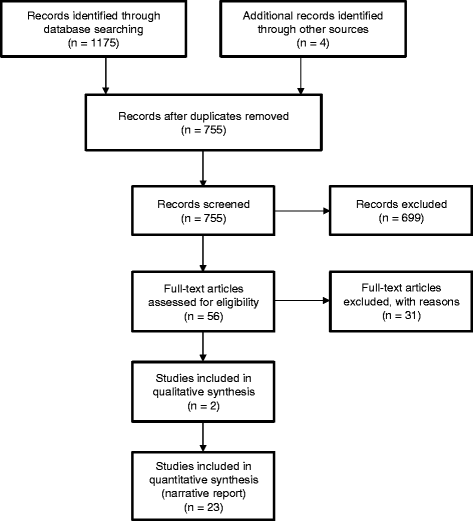A systematic review of factors influencing student ratings in undergraduate medical education course evaluations
- PMID: 25853890
- PMCID: PMC4391198
- DOI: 10.1186/s12909-015-0311-8
A systematic review of factors influencing student ratings in undergraduate medical education course evaluations
Abstract
Background: Student ratings are a popular source of course evaluations in undergraduate medical education. Data on the reliability and validity of such ratings have mostly been derived from studies unrelated to medical education. Since medical education differs considerably from other higher education settings, an analysis of factors influencing overall student ratings with a specific focus on medical education was needed.
Methods: For the purpose of this systematic review, online databases (PubMed, PsycInfo and Web of Science) were searched up to August 1st, 2013. Original research articles on the use of student ratings in course evaluations in undergraduate medical education were eligible for inclusion. Included studies considered the format of evaluation tools and assessed the association of independent and dependent (i.e., overall course ratings) variables. Inclusion and exclusion criteria were checked by two independent reviewers, and results were synthesised in a narrative review.
Results: Twenty-five studies met the inclusion criteria. Qualitative research (2 studies) indicated that overall course ratings are mainly influenced by student satisfaction with teaching and exam difficulty rather than objective determinants of high quality teaching. Quantitative research (23 studies) yielded various influencing factors related to four categories: student characteristics, exposure to teaching, satisfaction with examinations and the evaluation process itself. Female gender, greater initial interest in course content, higher exam scores and higher satisfaction with exams were associated with more positive overall course ratings.
Conclusions: Due to the heterogeneity and methodological limitations of included studies, results must be interpreted with caution. Medical educators need to be aware of various influences on student ratings when developing data collection instruments and interpreting evaluation results. More research into the reliability and validity of overall course ratings as typically used in the evaluation of undergraduate medical education is warranted.
Figures
Similar articles
-
The educational effects of portfolios on undergraduate student learning: a Best Evidence Medical Education (BEME) systematic review. BEME Guide No. 11.Med Teach. 2009 Apr;31(4):282-98. doi: 10.1080/01421590902889897. Med Teach. 2009. PMID: 19404891
-
The effectiveness of using non-traditional teaching methods to prepare student health care professionals for the delivery of mental state examination: a systematic review.JBI Database System Rev Implement Rep. 2015 Aug 14;13(7):177-212. doi: 10.11124/jbisrir-2015-2263. JBI Database System Rev Implement Rep. 2015. PMID: 26455855
-
Education support services for improving school engagement and academic performance of children and adolescents with a chronic health condition.Cochrane Database Syst Rev. 2023 Feb 8;2(2):CD011538. doi: 10.1002/14651858.CD011538.pub2. Cochrane Database Syst Rev. 2023. PMID: 36752365 Free PMC article.
-
Health professionals' experience of teamwork education in acute hospital settings: a systematic review of qualitative literature.JBI Database System Rev Implement Rep. 2016 Apr;14(4):96-137. doi: 10.11124/JBISRIR-2016-1843. JBI Database System Rev Implement Rep. 2016. PMID: 27532314
-
The measurement of collaboration within healthcare settings: a systematic review of measurement properties of instruments.JBI Database System Rev Implement Rep. 2016 Apr;14(4):138-97. doi: 10.11124/JBISRIR-2016-2159. JBI Database System Rev Implement Rep. 2016. PMID: 27532315
Cited by
-
Student curriculum review team, 8 years later: Where we stand and opportunities for growth.Med Teach. 2021 Mar;43(3):314-319. doi: 10.1080/0142159X.2020.1841891. Epub 2020 Nov 26. Med Teach. 2021. PMID: 33242263 Free PMC article.
-
Voluntary vs. compulsory student evaluation of clerkships: effect on validity and potential bias.BMC Med Educ. 2018 Jan 5;18(1):9. doi: 10.1186/s12909-017-1116-8. BMC Med Educ. 2018. PMID: 29304800 Free PMC article.
-
Reliability and construct validation of the Blended Learning Usability Evaluation-Questionnaire with interprofessional clinicians in Canada: a methodological study.J Educ Eval Health Prof. 2025;22:5. doi: 10.3352/jeehp.2025.22.5. Epub 2025 Jan 16. J Educ Eval Health Prof. 2025. PMID: 40134101 Free PMC article.
-
Do medical students feel career ready after their psychiatry clinical rotation?S Afr J Psychiatr. 2019 Nov 29;25:1397. doi: 10.4102/sajpsychiatry.v25i0.1397. eCollection 2019. S Afr J Psychiatr. 2019. PMID: 31824744 Free PMC article.
-
Using cognitive load theory to evaluate and improve preparatory materials and study time for the flipped classroom.BMC Med Educ. 2023 May 17;23(1):345. doi: 10.1186/s12909-023-04325-x. BMC Med Educ. 2023. PMID: 37198639 Free PMC article.
References
Publication types
MeSH terms
LinkOut - more resources
Full Text Sources
Other Literature Sources
Miscellaneous


